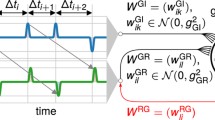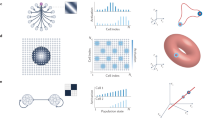Abstract
A phenomenological model is developed where complex dynamics are the correlate of spatio-temporal memories. If resting is not a classical fixed point attractor but a Milnor attractor, multiple oscillations appear in the dynamics of a coupled system. This model can be helpful for describing brain activity in terms of well classified dynamics and for implementing human-like real-time computation.
Preview
Unable to display preview. Download preview PDF.
Similar content being viewed by others
References
Varela, F., Lachaux, J.-P., Rodriguez, E., Martinerie, J.: The brainweb: Phase synchronization and large-scale integration. Nature Reviews Neuroscience (2001)
Buzsaki, G., Draguhn, A.: Neuronal oscillations in cortical networks. Science (2004)
Onton, J., Delorme, A., Makeig, S.: Frontal midline EEG dynamics during working memory. NeuroImage (2005)
Mizuhara, H., Yamaguchi, Y.: Human cortical circuits for central executive function emerge by theta phase synchronization. NeuroImage (2004)
Rainer, G., Lee, H., Simpson, G.V., Logothetis, N.K.: Working-memory related theta (4-7Hz) frequency oscillations observed in monkey extrastriate visual cortex. Neurocomputing (2004)
Tsujimoto, T., Shimazu, H., Isomura, Y., Sasaki, K.: Prefrontal theta oscillations associated with hand movements triggered by warning and imperative stimuli in the monkey. Neuroscience Letters (2003)
Goldman-Rakic, P.S.: Cellular basis of working memory. Neuron (1995)
McCormick, D.A.: Neuronal Networks: Flip-Flops in the Brain. Current Biology (2005)
Durstewitz, D., Seamans, J.K., Sejnowski, T.J.: Neurocomputational models of working memory. Nature Neuroscience (2000)
Yamaguchi, Y.: A Theory of hippocampal memory based on theta phase precession. Biological Cybernetics (2003)
Kaneko, K.: Dominance of Minlnor attractors in Globally Coupled Dynamical Systems with more than 7 +- 2 degrees of freedom (retitled from ‘Magic Number 7 +- 2 in Globally Coupled Dynamical Systems’) Physical Review Letters (2002)
Fujii, H., Tsuda, I.: Interneurons: their cognitive roles - A perspective from dynamical systems view. Development and Learning (2005)
Tsuda, I.: Towards an interpretation of dynamic neural activity in terms of chaotic dynamical systems. Behavioural and Brain Sciences (2001)
Author information
Authors and Affiliations
Editor information
Rights and permissions
Copyright information
© 2008 Springer-Verlag Berlin Heidelberg
About this paper
Cite this paper
Colliaux, D., Yamaguchi, Y., Molter, C., Wagatsuma, H. (2008). Working Memory Dynamics in a Flip-Flop Oscillations Network Model with Milnor Attractor. In: Ishikawa, M., Doya, K., Miyamoto, H., Yamakawa, T. (eds) Neural Information Processing. ICONIP 2007. Lecture Notes in Computer Science, vol 4984. Springer, Berlin, Heidelberg. https://doi.org/10.1007/978-3-540-69158-7_18
Download citation
DOI: https://doi.org/10.1007/978-3-540-69158-7_18
Publisher Name: Springer, Berlin, Heidelberg
Print ISBN: 978-3-540-69154-9
Online ISBN: 978-3-540-69158-7
eBook Packages: Computer ScienceComputer Science (R0)




